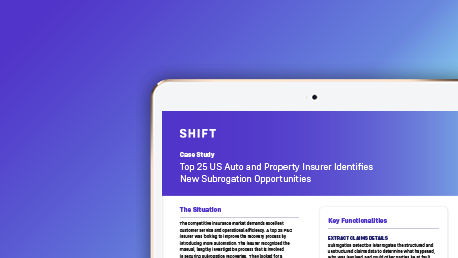AI-Powered Subrogation Detection and its Impact on the Combined Ratio
The third in a series of commentaries on the combined ratio problem facing the global insurance industry
Executive Summary
- Approximately 15% of P&C claims are closed with missed subrogation opportunities, costing the insurance industry between $15-20 billion annually
- It takes an average of 6 months for insurers to complete the subrogation process
- Best in class subrogation and recovery efforts can positively impact the combined ratio by up to 4%
- Insurers stand to recoup up to an additional 7% of a claim’s total value when AI is applied to the subrogation and recovery problem
The insurance industry faced an average combined ratio of nearly 102% exiting 2023. And according to widely accepted industry estimates, approximately 15% of P&C claims are closed with missed subrogation opportunities. That represents a cost of between $15-20 billion annually, with some calculations putting the cost at closer to $30 billion. Since those missed opportunities directly impact the bottom line, and ultimately the combined ratio, it stands to reason that more effective subrogation and recovery can have a profound
impact on an insurer’s bottom line.
As an industry we have also seen that a strategy that relies only on raising premiums is not enough to have the desired effect on the combined ratio. Furthermore, focusing solely on increasing premiums also creates the real risk of driving customer dissatisfaction if policyholders believe they are being treated unfairly. This can create churn and the new problem of replacing top-line revenue. As such, applying best practices to the subrogation and recovery process represents an excellent opportunity to shave points off of the combined ratio.
Using artificial intelligence (AI) generally, and generative AI (Gen AI) more specifically, to help insurers detect hidden subrogation and recovery opportunities, assess liability and likelihood of recovery, as well as surface and apply relevant negligence/fault legislation is one of the most effective ways to modernize this important process. The result is fast, accurate, and fair subrogation and recovery that benefits both insurers and their customers and helps to address the continuing combined ratio problem.
Solving the Time Gap
"The only way to bridge the divide is through effective subrogation and recovery."
One of the most interesting aspects of the relationship between premiums and subrogation and recovery is the impact time has on claims. If we look simply at the divide between premiums and claims costs, it is important to remember that even if an insurer does raise rates, the majority of claims on the books will have been made on premiums that were already paid. And since premium increases cannot be applied retroactively, the only way to bridge the divide is through effective subrogation and recovery. The ability to maximize not only the number of opportunities, but also the likelihood of recovery is just one powerful way AI can benefit subrogation and recovery efforts, and in turn positively impact the combined ratio.
Time can also affect the ultimate value of recovered claims. Insurers typically have between 2-5 years (and in some jurisdictions up to 10) to pursue subrogation and recovery opportunities. On the surface, this seems to benefit carriers in that it provides a long runway to recover costs from a third-party. However, the same inflationary pressures that are driving the industry’s combined ratio challenge are driving down the real value of the amount recovered. Considering that it takes an average of 6 months for insurers to complete the subrogation process, insurers who are able to more efficiently and effectively execute the subrogation process are more likely to retain as close to full claim value as possible.
Bridging the Skills Gap
It can take years of experience for a claims professional to build the expertise required for true effectiveness associated with improving viability and timely pursuit of subrogation and recovery opportunities. At the same time, the expertise of individual subrogation experts is incredibly difficult to scale. And due to factors such as “The Great Resignation” and other related labor issues, insurers find themselves facing a lack of skilled employees able to execute subrogation and recovery to an extent where it meaningfully impacts the combined ratio.
Fortunately, AI has proven itself valuable in this area. Insurers augmenting subrogation and recovery efforts with AI inject significant efficiency into the process, effectively applying the expertise and experience of their best subrogation specialists at scale. And since advanced AI can not only detect, but also explain the reasons and rationale for alerting on a specific claim, less experienced team members can make a larger impact. This is critically important when you consider that insurers stand to recoup up to an additional 7% of a claim’s total value when AI is applied to the problem.
Subrogation and Recovery in Different Jurisdictions
Insurance is a highly regulated industry and the regulations that govern it often differ greatly depending on which jurisdiction you are doing business in. How fault is assigned, especially in the case of auto accidents, can also vary according to local laws. These factors can complicate how subrogation and recovery opportunities are pursued, or even if they are.
"AI can be used to mitigate these factors by applying the correct analysis to the claim."
AI can be used to mitigate these factors by applying the correct analysis to the claim based on the laws and regulations of the jurisdiction in which the incident occurred. For insurers doing business in multiple jurisdictions, but who may employ a centralized approach to claims handling, having AI know which scenarios to apply to which claims ensures subrogation and recovery opportunities are surfaced correctly regardless of which handler is working them and where.
This kind of situation can also result when an insurer established in one jurisdiction decides to begin doing business in another, and may be unfamiliar with the nuances of local regulations with which they are not familiar. Due to a fundamental lack of understanding, claims handlers may believe a subrogation and recovery opportunity does not exist, and thus identifies the claims as such. Each missed opportunity results in hard dollars that could be recovered which instead increases the combined ratio. AI-powered subrogation and recovery makes it easier to retroactively identify claims that may have been mislabeled and pursue recovery. As important, analysis using AI models tuned to the nuances of all the jurisdictions in which an insurer does business can help avoid this situation in the first place by automatically, and accurately, identifying claims with a high probability of recovery.
Conclusion
"Our own research has shown that [best-in-class subrogation and recovery efforts] can positively impact the combined ratio by up to 4%."
Missed subrogation and recovery opportunities have long been viewed by the insurance industry as a whole as simply the cost of doing business. Whatever dollars they could recoup were seen as a bonus as opposed to having a meaningful impact on the bottom line. However, as insurers faced burgeoning combined ratios, it became clear that driving best-in-class subrogation and recovery efforts could truly benefit the business. Our own research has shown that doing so can positively impact the combined ratio by up to 4%, which for many insurers could be the difference between operating in the red versus the black. Subrogation and recovery is not easy. It is a complicated and nuanced process shaped by local laws and regulations. Applying AI to the problem allows insurers to augment the skills and expertise of their employees, accurately and efficiently uncover hidden opportunities, understand liability sooner in the process, and even improve the policyholder experience.
The Combined Ratio Series
This is the third in a series of commentaries on the combined ratio problem facing the insurance industry. For further discussion of this topic and how the application of AI is addressing this challenge throughout the policy lifecycle, continue reading.
All posts in the series
- The Combined Ratio Problem: Closing the Gap Between Claims Costs and Premiums using AI
- Underwriting Risk and its Impact on the Combined Ratio
- AI-Powered Subrogation Detection and its Impact on the Combined Ratio
- Claims Fraud Detection and its Impact on Combined Ratios
About the Author



